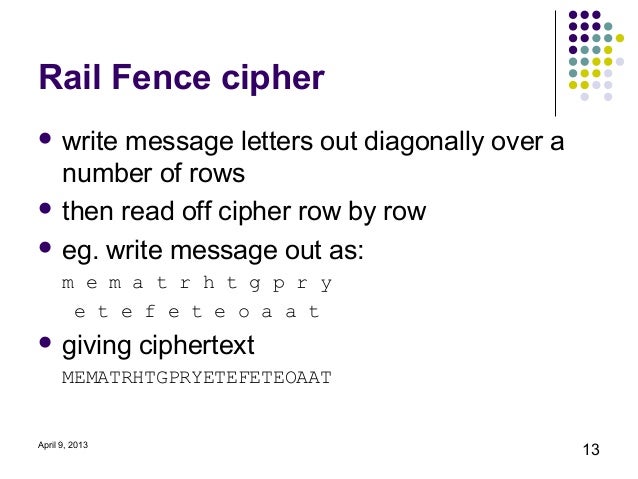Rail Fence Cipher Program Code
The rail-fence cipher is a transposition cipher that rearranges the characters of a clear-text to form the cipher-text. The clear-text is arranged in up-and-down waves like the tops of the pickets on a rail fence; the cipher key is the height of the fence. For instance, the encipherment of “PROGRAMMING PRAXIS” with a key of 4 is shown below, using an underscore to make the space character visible: P R O G R A M M I N G P R A X I S P M P = P M P R A M R S = R A M R S O R I G A I = O R I G A I G N X = G N X The cipher-text is read at the right of the pickets: “PMPRAM RSORIGAIGNX”. Your task is to write functions that encipher and decipher texts using the rail-fence method. When you are finished, you are welcome to or a suggested solution, or to post your solution or discuss the exercise in the comments below. Said FalconNL, your design turns the solution into “Fortran”, using indexes into lists (of chars) where a generative-recursion design (for freshmen) exposes the waves as they come about. Then again, you demonstrate how temporary laziness in ‘waves’ is a useful tool.

Rail Fence Cipher Decoder
Feb 23, 2013 In the rail fence cipher, the plaintext is written downwards and diagonally on successive 'rails' of an imaginary fence, then moving up when we reach the. The Rail Fence Cipher is a transposition cipher that uses a table that looks a bit like an old rail fence viewed from above. Apr 27, 2015 In the rail fence cipher, the plaintext is written downwards and diagonally on successive 'rails' of an imaginary fence, then moving up when we reach the.
Let me show you how temporary, invisible assignments accomplish the exact same purpose.;; Listof X Nat - Listof X;; 1 5 9;; 1 2 3 4 5 6 7 8 9 10 11 2 4 6 8 10 1 5 9 2 4 6 8 10 3 7 11;; 3 7 11 (check-expect (fence ‘(1 2 3 4 5 6) 3) ‘(1 5 2 4 6 3)) (check-expect (fence ‘(1 2 3 4 5 6 7 8 9 10 11) 3) ‘(1 5 9 2 4 6 8 10 3 7 11)) (define (fence s n) (define is (shared ((x (append (range 1 n) (range (- n 1) 2) x))) x)) (define wv (for/list ((c s)) (begin0 (list c (car is)) (set! Is (cdr is))))) (map first (sort2 wv))). FalconNL said Updated version that I believe should run in O(n log n) for both rail and derail (rail was O(n^2) in the previous version): import Data.List import GHC.Exts main = do print $ rail 4 'PROGRAMMING PRAXIS' print.
Derail 4 $ rail 4 'PROGRAMMING PRAXIS' rail:: Int - a - a rail n = zipSort (cycle $ 1.n n-1,n-2.2) derail:: Ord a = Int - a - a derail n s = zipSort (rail n $ zipWith const 0. s) s zipSort:: Ord a = a - b - b zipSort ks = map snd. SortWith fst.

In the rail fence cipher, the is written downwards and diagonally on successive 'rails' of an imaginary fence, then moving up when we reach the bottom rail. When we reach the top rail, the message is written downwards again until the whole plaintext is written out. The message is then read off in rows. For example, if we have 3 'rails' and a message of 'WE ARE DISCOVERED. FLEE AT ONCE', the cipherer writes out: W.